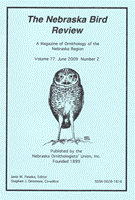Nebraska Ornithologists' Union

Nebraska Bird Review
Date of this Version
6-2023
Document Type
Article
Citation
The Nebraska Bird Review Vol. 91 No. 2, pp. 46-70
Abstract
First off, I want to reiterate that reports compiled for this Spring Seasonal Report are evaluated against current knowledge as presented in Birds of Nebraska-Online (“BONO”; https://birds.outdoornebraska.gov/). Species whose reports do not add new information on distribution, early or late dates, etc., are listed as having “Routine reports”. Please let me know at silcock@rosssilcock.com if you have information that is not in BONO, or if you have additions and/or corrections of information in BONO. Another reminder: if evidence of breeding is observed, please enter the appropriate descriptor in your eBird checklist under “Breeding and Behavior Code”. These descriptors can be found at eBird Breeding and Behavior Codes: Help Center. Of interest this spring was the effect the Nebraska Game and Parks Commission’s competitive Birding Bowl had on numbers of reports and on a few select total warbler counts. The number of checklists was up, keeping reviewers busier than usual, especially due to entry of two checklists per field trip, one for a personal list the other for the competition. It would seem to follow that total numbers of warblers would increase as well; this happened for several species, notably American Redstart, Magnolia Warbler, Bay-breasted Warbler, Blackburnian Warbler, Chestnut-sided Warbler, and Blackpoll Warbler, all of which are in the mid-level of normal abundance that one might expect would be increased with additional field effort. In contrast, however, Black-throated Green Warbler was lower than usual, and Canada and Wilson’s Warblers did not show increases. Another expected result of increased effort might be more reports of rare warblers; with the possible exception of Connecticut Warbler and Bay-breasted Warbler (normally a spring rarity), rare warblers were not more conspicuous than usual. The six Black-billed Cuckoos, reports of Scissor-tailed Flycatcher from six locations, possibly Dusky Flycatcher, several reports of Tufted Titmouse in Lancaster Co, Carolina Wren throughout, and Gray-cheeked Thrush, might have been Birding Bowl effects. Perhaps the most surprising overall phenomenon was the crazy numbers of waterfowl, almost across the board species-wise, but most notable among the geese and dabbling ducks. Estimates were of 2.5 million Snow Geese passing through the state, the associated 170,000 Ross’s Geese, 10,000 Greater White-fronted Geese, and 100,000 Canada Geese. Among dabblers, 2nd highest record single person-single location counts, oddly, occurred in four species: 150,000 Mallards, 75,000 Northern Pintails, 8000 Green-winged Teal, and 3500 Gadwall. Canvasback numbers were good at 3000.
Included in
Ornithology Commons, Population Biology Commons, Poultry or Avian Science Commons, Zoology Commons


Comments
Published by the Nebraska Ornithologists’ Union, Inc.